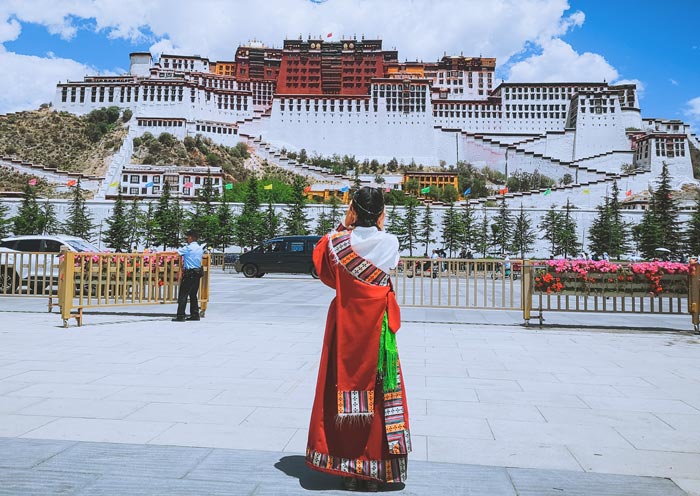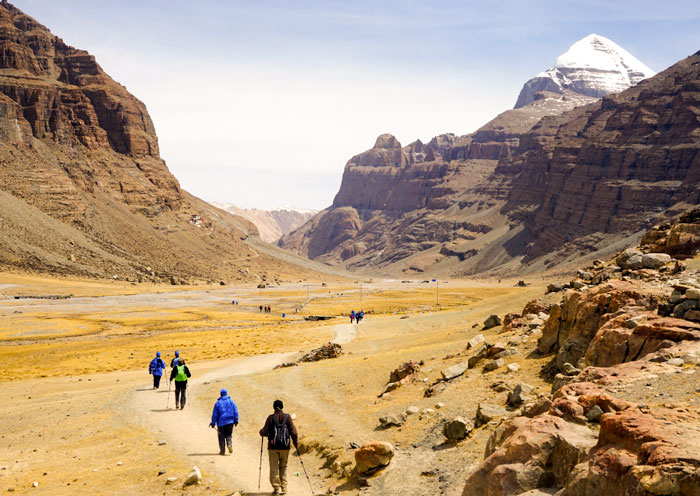Temple Tales: Bond Between Tibetan Plateau and Inner Mainland
Historical records reveal centuries of exchange between the Tibet plateau and the Central Mainland of China. The earliest contact can be traced back to the Han dynasty (206 BC - 220 AD). These exchanges endured through the Tang dynasty (618-907 AD). Close ties between Tibet plateau and the central part of China fostered frequent exchange of goods, people, and ideas during these periods.
The close ties can be seen in the Temples and Monasteries in Lhasa built along the history. Let’s take a history tour through Lhasa monasteries and Lhasa temples.
Jokhang Temple: Discover How Lhasa was Named
Highlights: the life-size image of 12-year-old Jowa Sakyamuni, Full view of Potala from golden roof
Name Origin: Jokhang Temple, “Khang” means home, “Jo” refers to the Jowo Sakyamuni, the temple is the home of the Jowo Sakyamuni statue, hence the name Jokhang.
The Jokhang Temple (大昭寺), is located in the Barkhor Square in Lhasa, Tibet(Xizang), China. Jokhang Monastery is one of the most sacred and valued monasteries in Tibetan Buddhism.
Originally the Jokhang monastery was called Rasa Trulnang. Tsuklakang, means "House of Mysteries" or "House of Religious Science". The word “Rasa” also is the origin of the name “Lhasa”.
In the 11th century, it was rebuilt and renamed Jokhang Temple. This name Jokhang is significant because it embodies the Tibetan belief that the temple is the dwelling place of the Jowo Sakyamuni statue, the renowned relic of the Jokhang Temple. holds great significance and is a major draw for pilgrims visiting Lhasa.
It was brought to Tibet by Princess Wencheng of the Tang Dynasty from mainland part of China, symbolizing a strong connection between the Tibetan plateau region and the inner regions of China. This relic serves as a primary reason why the Jokhang Temple temple attracts hundreds of thousands of worshipers.
The Jokhang Temple became a part of the UNESCO World Heritage sites in 2000, as an addition to the Potala Palace. Check out more details in this thorough Jokhang Temple Guide.
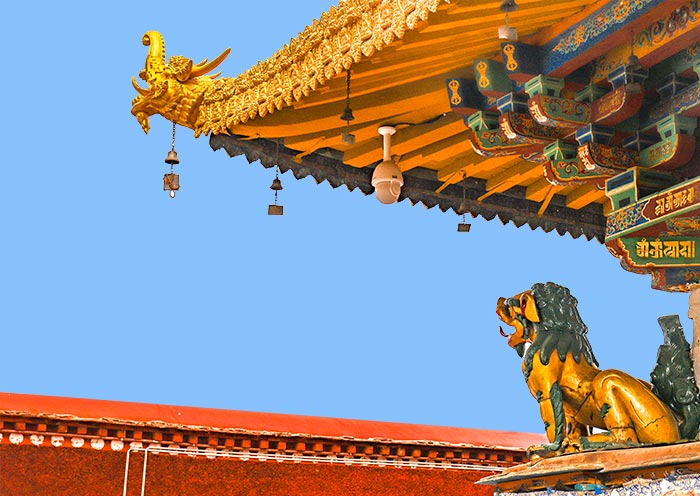
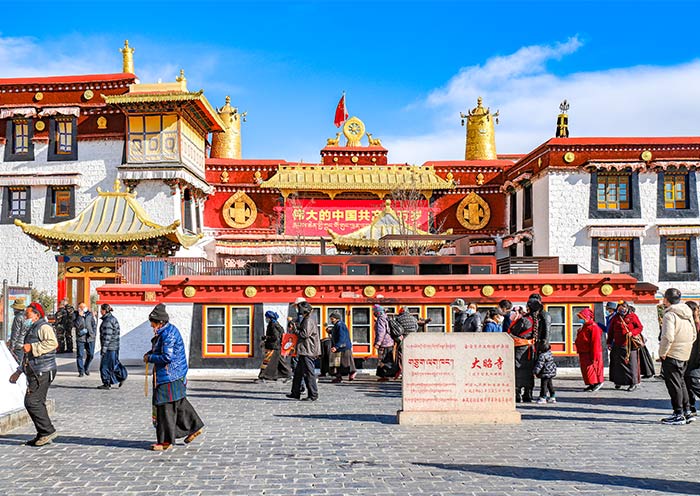
Ramoche Monastery: Princess Wencheng’s Legacy in Lhasa
Highlights: Jowo Statue, Murals
Name Origin: The name Ramoche Temple is derived from the combination of two Tibetan words: "ramoche," meaning "auspicious" or "blessed," and "dgonpa," meaning "monastery" or "temple." Thus, the name Ramoche Temple literally translates to "auspicious temple."
Ramoche (小昭寺) is located in the northwestern part of the Tibetan capital, Lhasa. It is east of the Potala Palace and north of the Jokhang Temple. With a total area of 4,000 square meters, the Ramoche Temple is an important cultural heritage site and a popular attraction in Lhasa.
Within the Ramoche Temple resides a small bronze statue of the Buddha at the age of eight, skillfully crafted by Vishvakarman.
Built during the Tang Dynasty, a period of significant Chinese influence in Tibet(Xizang), the temple exhibits strong Tang architectural elements. Princess Wencheng, the bride of King Songsten Gampo, oversaw the project and had the temple facing east as a reflection of her longing for her homeland.Princess Wencheng played a significant role in Tibetan history after she reached Lhasa.
Zaki Temple:The Only Temple in Lhasa Devoted to Prosperity
Highlights: Goddess of Wealth, Fortune-telling divination sticks
Name Origin: The term "Zha Ba" in Tibetan translates to "monks," while "Ji" can be understood as "four." Therefore, the literal meaning of Zhaji Temple is a temple that houses four monks.
Situated 10 km north of Lhasa, Zaki Temple (扎基寺, also spelled Tshuglhakhang) is a branch temple of the renowned Sera Monastery, one of Tibet's three great Gelugpa monasteries. Noted for its distinctive architecture, Zaki Temple stands out for its remarkable assortment of statues and relics associated with wealth. It is regarded as the sole temple in Tibet exclusively devoted to matters of prosperity. According to legend, the wealth deity of Zaki Temple originated from the Central Plains region of China and accompanied a prominent Tibetan monk back to Lhasa, eventually becoming a well-known deity associated with wealth.
On the second floor of the temple is a small Buddhist chapel. Some Lhasa locals come here to draw divination sticks to foresee future.
Pangkha Monastery: Birthplace of the Tibetan Alphabet
Highlight: World's first stone slab with the six-syllable mantra, overview of Lhasa City
Name Origin: Pangkha is a Tibetan term meaning "holy place," the name Pangkha is believed to signify the monastery's location. Positioned atop a hill, overlooking the Lhasa Valley.
Pangkha Monastery (邦喀寺) is located in the north of Lhasa city. It was the center of politics and Buddhism during the Tibetan Empire, and it is also the birthplace of the Tibetan alphabet. In the past, Songtsen Gampo practiced here, received foreign envoys, and discussed state affairs.
Thönmi Sambhota, who created the Tibetan alphabet, personally wrote the six-syllable mantra "Om mani padme hum" on a stone slab. This stone slab is also the world's first stone slab with the six-syllable mantra.
There is a yellow building there, is said to be the balcony of Princess Wencheng. After Princess Wencheng entered Tibet(Xizang), the Potala Palace had not yet been built, so she lived here. From here, you can see the whole city of Lhasa in the distance.


The "Great Three Monasteries" in Lhasa
The Gelugpa sect, commonly referred to as the Yellow Hat sect, holds significant influence as the dominant sect of Tibetan Buddhism in Lhasa. Several factors contribute to its prominence, including the emphasis on monastic education, historical patronage, and widespread popularity.
Sera Monastery, Drepung Monastery, and Ganden Monastery are collectively referred to as the Great Three Monasteries of Lhasa. As the main Gelugpa monasteries in Tibet, they hold great importance and have played a central role in Tibetan history and culture for centuries. Situated in the heart of Tibet(Xizang), Lhasa, these monasteries have a significant place in the Lhasa region's heritage.
Ganden Monastery: The Most Noteworthy in Lhasa
Highlights: Ganden Monastery Incense, Scenic Ganden Kora, Origin of Gelug
Name Origin: The complete name of the monastery is "Ganden Namgyal Ling," which signifies the "temple of joyful victory" when translated.
Ganden Monastery (甘丹寺), situated approximately 40 kilometers east of Lhasa, is the smallest among the Great Three Monasteries, yet Ganden Monastery holds significant importance in Tibetan Buddhism. Renowned for its rigorous monastic discipline and picturesque surroundings, Ganden Monastery stands as a noteworthy institution.
Additionally, there is the Ganden Monastery Incense. Unique to the vicinity of Ganden Monastery, a magical herb known as Ganden Khempa, also called "Tibetan Sage Incense" or "Obstacles Clearing Grass," grows. This herb emits a distinct and subtle fragrance, setting it apart from Khempa grown in other regions. Get the incense from Ganden Monastery would be a great thing to do visiting Lhasa!
Drepung Monastery: Largest Gelupa Monastery in Lhasa
Highlights: Drepung Shoton Festival, The largest among the six major Gelugpa monasteries in Lhasa
Name Origin: "Drepung" which means "rice heap" in Tibetan. The name symbolizes prosperity,
Drepung Monastery (哲蚌寺), situated around 5 kilometers west of Lhasa, is the largest monastery in Tibet(Xizang) and was once home to more than 10,000 monks. It is celebrated for its vast collection of Buddhist scriptures and breathtaking murals, making it a remarkable cultural gem. With its profound influence among Tibetan Buddhist monasteries, Drepung Monastery serves as a nurturing ground for Buddhist scholars in Lhasa.
Drepung Shoton Festival (雪顿节): Experience the magnificent unfolding of the Buddha ceremony during the Drepung Shoton Festival in Lhasa. This annual festival occurs in August, specifically on the 30th day of the 6th month in the Tibetan calendar, and spans a week. With its association with the "Yogurt Banquet Festival," "Tibetan Opera Festival," and "Buddha Exhibition Festival," the Shoton Festival offers a vibrant celebration of Tibetan culture, and it is easily accessible from Lhasa city.
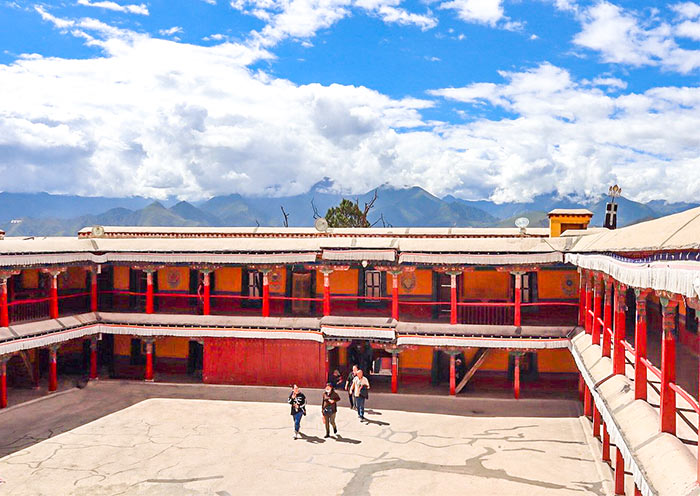
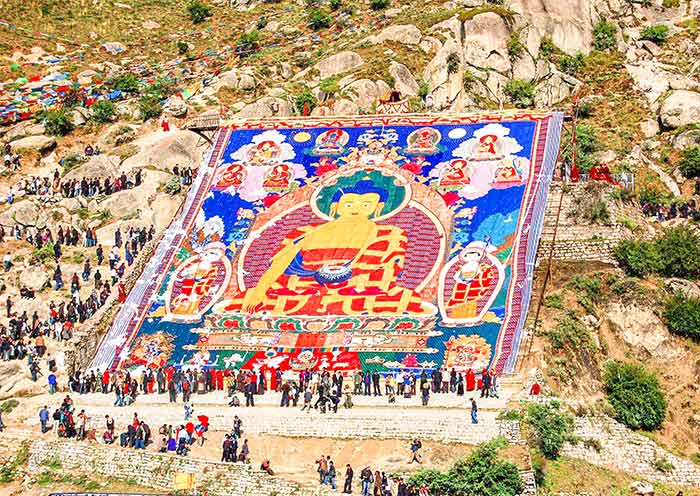
Sera Monastery: The Buddhism Scholar Center in Lhasa
Highlights: Debate, Sera Monastery Library, Sand Mandala, Printing Rooms
Name Origin: The Tibetan name "Sera" translates to "Wild Roses." Hence, the Sera Mahayana Monastery is known as the "Wild Roses Monastery of Great Vehicle."
Situated approximately 6 kilometers north of Lhasa, Sera Monastery (色拉寺) was founded in the 15th century. It gained renown for its renowned daily public debates and impressive collection of Buddhist scriptures and murals. The monastery's courtyard debates, held every afternoon except Sundays, are particularly famous.
In 2007, in collaboration with the Lhasa government, the monastery established a Library to house an extensive collection of Buddhist texts and scriptures related to lama studies and Buddhist philosophy.
Adjacent to the library, there is a Sand Mandala room where visitors can engage with Tibetan Buddhist philosophy. The creation and subsequent dismantling of intricately designed mandalas made from colored sand is a central tradition in Tibetan Buddhism. It would be an authentic experience for you when visiting Lhasa.
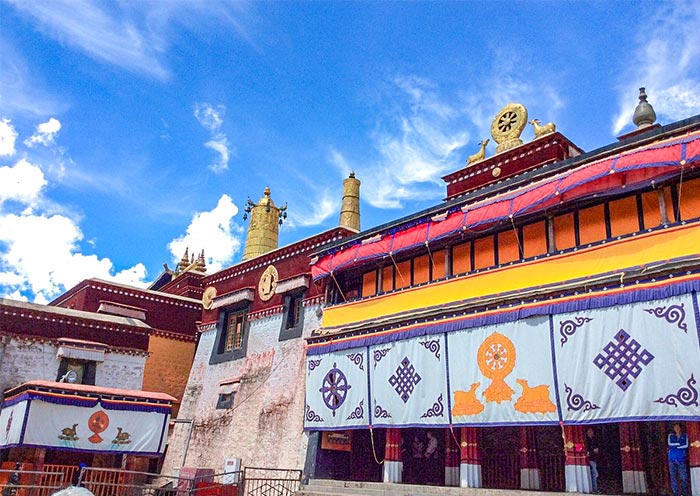
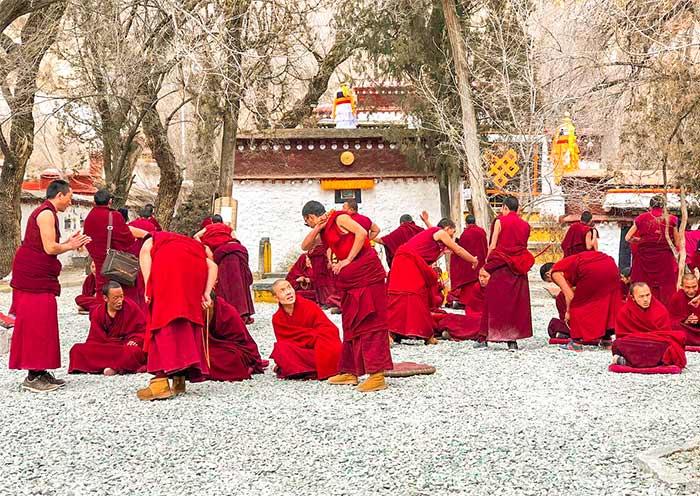
Tibetan Culture Unfolding in Lhasa Monasteries
The monasteries in Lhasa hold a significant position in Tibetan culture, serving as focal points for learning, pilgrimage, and ritual practices. They also serve as repositories of Tibetan art, architecture, and literature. If you have a keen interest in understanding Tibetan culture, exploring the monasteries in Lhasa offers a profound opportunity to immerse yourself in its richness and depth.
Drak Yerpa Monastery: The Must-visit Monastery of Lhasa
Hilights: Holy Cave Retreat, Natural Scenery, Characteristic Architectures, Monastery Built on Cliffs
Name Origin: The name Drak Yerpa Monastery, derived from the Tibetan words 'Brag' (rock) and 'Yer Pa' (sacred), translates to "sacred rock monastery".
Drak Yerpa (扎耶巴寺), a sacred monastery located 36 kilometers from Lhasa City, is built into the cliffs and dates back to the 7th century AD. With a history spanning over 1,500 years, it is one of Tibet's renowned monasteries. The monastery primarily venerates the Maitreya Buddha, and visitors can observe numerous caves where esteemed monks practiced.
This vast complex encompasses temples, monasteries, and meditation caves nestled on the mountain. There is a popular folk song that describes Drak Yerpa,“the sacred place of Tibet is Lhasa while the sacred place of Lhasa is Drak Yerpa”.
In Drak Yerpa Monastery, over 100 meditation caves once existed, varying in scale and shape. Renowned figures such as King Srongtsen Gampo, Padma Sambhava, and Venerable Atisha are said to have practiced there. Today, approximately 16 well-preserved caves remain, adorned with lifelike statues and captivating murals.
Tsurphu Monastery: Where the Incarnation Started
Highlights: Starting point of the incarnation system of living Buddha,Buddha Relics, Tsurphu Cham Dance Festiva
Name Origin: The name Tsurphu Monastery, originating from the Tibetan words "mtshur" (spring) and "phu" (place), translates to "spring place monastery".
Tsurphu Monastery (楚步寺), located in the Tolung Valley about 60 kilometers north of Lhasa, embodies the Karma Kagyu Sect of Tibetan Buddhism, boasting an 800-year history. Founded by the 1st Karmapa, Dusum Khyenpa, it upholds the tradition of the living Buddha incarnation system, passed down by Tibetan Buddhist leaders.
Inside the monastery, you'll discover Sarira (Buddha relics) and magnificent statues depicting 13 Buddhas.
The Tsurphu Cham Dance Festival, held on the 10th day of the fourth month in the Tibetan calendar, is a vibrant celebration honoring Padmasambhava, the esteemed Indian guru who played a crucial role in the dissemination of Buddhism in Tibet(Xizang).
Drigung Til Monastery: Holy Sky Burial Site Near Lhasa
Highlights: Sky Burial, Stunning Valley View,
Name Origin: The name Drigung Til Monastery, derived from the Tibetan words 'bri' (female yak or Drigung region), 'gung' (middle or center), and 'mthil' (plain or level ground), can be translated as "Drigung Plain Monastery" or "Female Yak Center Monastery".
Drigung Til Monastery (直贡梯寺), located approximately 72 kilometers north of Meldre Gungkar in the captivating Shorong Tsangpo valley, offers breathtaking views of the valley below as it is built into a sheer cliff. The charnel grounds, situated behind the monastery, can be found further up. It’s a foot on the ground, or shall we say foot on the cliff tour destination if you would like to have a hiking tour when visiting Lhasa.
For Tibetan Buddhists, cremation and sky burial carry great significance, serving as powerful reminders of life's impermanence and embodying acts of generosity and compassion. The surrounding mountain ridges hold deep importance as sky burial sites.
How to Plan Your Tibet Tours with Top Attractions?
Tibet is a region of immense size and diversity, boasting a rich cultural heritage, breathtaking natural beauty, and a unique fusion of Buddhism and traditional Tibetan culture. With so much to explore and experience, first-time visitors are advised to spend 8 to 15 days in Tibet to fully appreciate the region's history, culture, and awe-inspiring landscapes.


Here are some Curated Themed Itineraries
Tour Lhasa City - 4 Days
For 4 days, it is highly recommended to take: 4 Days Lhasa & Surrounding Tour
Add 2 or 3 More Days to Visit Gyantse & Shigatse
For 5 days, it is highly recommended to take: 5 Days Lhasa & Yamdrok Lake Tour
For 6 days, it is highly recommended to take: 6 Days Lhasa Yamdrok Lake Shigatse Tour
Add 2 More Days to Mount Everest
For 7 days, you can take 7 Days Classic Tibet Nepal Overland Tour from Lhasa to Gyirong via EBC
For 8 days, you can take Lhasa - Yamdrok Lake - Shigatse - Mount Everest - Lhasa for classic exploration
To extend further, you can cover Mount Kailash (3 Days), Guge Kingdom & Zanda Earth Forest (1 Day), Namtso Lake (1 Day), etc.
9 Days Panorama Tibet Tour from Lhasa to EBC with Namtso Lake
15 Days: Lhasa - Yamdrok Lake - Mount Everest - Mount Kailash - Zanda - Shigatse - Lhasa
Alternatively, you can just simply pick the Month You are Planning to Visit, choose your tour accordingly
Explore Tibet with Asia Odyssey Travel
With over 10 years of local expertise in Lhasa and Tibet (Xizang), our dedicated team at Asia Odyssey Travel brings you carefully curated Tibet tours for an authentic and unforgettable experience.
Drawing upon our extensive experience, we have meticulously crafted a range of Tibet tour packages, including Lhasa tours, Mount Everest Tours, Mount Kailash Tours, Tibet Trekking Tours, Tibet Train Tours, and Tibet Overland Tours. Whether you prefer the comfort and flexibility of a private tour or the budget-friendly option of a group tour, we have you covered without compromising on quality.
Additionally, we cater to various travel preferences, whether you wish to commence your Tibet tour from one of the popular gateway cities in China, embark on Nepal Tibet tours, or even explore the mesmerizing Himalayan region. Whatever you desire, Asia Odyssey Travel has the perfect tour to meet your needs, ensuring that your expedition to Tibet (Xizang) becomes an unforgettable adventure.






